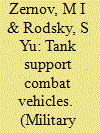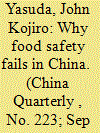|
|
|
Sort Order |
|
|
|
Items / Page
|
|
|
|
|
|
|
| Srl | Item |
| 1 |
ID:
107257


|
|
|
|
|
| Publication |
2011.
|
| Summary/Abstract |
The author describes basic scientific, methodological, technological, and organizational tasks of designing and manufacturing of composite software products of high quality for custom-made military control and information processing systems.
|
|
|
|
|
|
|
|
|
|
|
|
|
|
|
|
| 2 |
ID:
162550


|
|
|
|
|
| Summary/Abstract |
This study estimates a three-sector Feder–Ram model using US annual data for 1965–2014 to confirm the externality of defense expenditure in the United States. Although the model is often used in the literature to scrutinize whether this effect exists, a flaw intrinsic to this model is the appearance of multicollinearity. In this study, I introduced novel techniques, namely: the standardization and estimation of a simple slope, to estimate the model. The results are as follows. First, I prove that the multicollinearity problem can be resolved by standardization. Second, externality, which is judged to conventionally exist, is not found. Third, increases in defense expenditure bring about positive but limited economic growth when the ratio of private to defense expenditure in the previous year ranges from 5.09 to 6.82%. By re-estimating the model, this study contributes to developing the Feder–Ram model within the related literature.
|
|
|
|
|
|
|
|
|
|
|
|
|
|
|
|
| 3 |
ID:
121074


|
|
|
|
|
| Publication |
2013.
|
| Summary/Abstract |
Over the past decade, defence capital acquisition reforms have enhanced standardization, transparency and bigger acquisition budgets. Yet the system grapples with delays, cost escalations and gaps in operational preparedness. This article explores the structure, process and cultural dimensions of the acquisition system, unpacking the underlying linkages between policy, planning, budgeting, strategic direction, and outcomefocused analytical decision-making-factors that influence effectiveness of the procurement system. The author makes a comparative study of the defence acquisition system of six countries, learning from the reforms and relentless pursuit of efficiency and effectiveness in USA, UK and France and the evolving systems of Australia, Brazil and Canada. The article seeks to steer the reforms debate beyond procurement procedures to performance management, strategic planning and risk management, towards delivering a culture of professionalism, innovation and outcomefocused decision-making to establish an acquisition system that best suits India's defence needs.
|
|
|
|
|
|
|
|
|
|
|
|
|
|
|
|
| 4 |
ID:
180114


|
|
|
|
|
| Summary/Abstract |
This paper introduced a standardization strategy of China's nuclear industry based on a jointed consulting research and tried to find out the current issues and unsolved problems of standardization in China's nuclear industry. Standardization plays an important role in supporting industrial development and promoting scientific and technological progress. As a high-tech industry and a cornerstone of national security, China's nuclear industry has to be faced the new challenge and met the actual demand in the new era. Under the circumstance, standardization is expected to accelerate the safe and innovative development, to guarantee the peaceful use of nuclear energy, to comprehensively enhance the core competitiveness and lead high-quality development of the nuclear industry. Via focusing on restrictive factors, the current research presented a main output mode of standardization work, and proposed the implementation paths and specific suggestions for the standardization strategy of China's nuclear industry. At last, the policy recommendations were concluded as (1) establishing a synchronous implementation mechanism for major scientific research or engineering projects and standard development; (2) improving the integration of independent standard system with the nuclear safety regulation system; (3) encouraging and supporting preponderant association/society in nuclear industry to enact corresponding group standards.
|
|
|
|
|
|
|
|
|
|
|
|
|
|
|
|
| 5 |
ID:
124425


|
|
|
|
|
| Publication |
2013.
|
| Summary/Abstract |
The study of the transnational transfer of practices and institutions generally looks at the intermediary and final stages of the process, with much less attention devoted to its initial steps. In contrast, this article theorizes the early part of the trajectory of transfer, conceptualized as the process through which local ideas and practices are turned into a "standard model," which we term the process of standardization. Drawing upon the public policy and social movement literatures, we identify three potentially robust mechanisms as central to the process of standardization-certification, decontextualization, and framing-and apply this framework to two cases: the transnational spread of Truth and Reconciliation Commissions and the use of conditional cash transfers as a social policy instrument. We find that the key actors in shaping the content of these standards were neither the innovators nor the early adopters but intermediary entrepreneurs located at the intersection of a complex mix of state and nonstate networks.
|
|
|
|
|
|
|
|
|
|
|
|
|
|
|
|
| 6 |
ID:
118341


|
|
|
|
|
| Publication |
2012.
|
| Summary/Abstract |
The paper argues the need to introduce tank support combat vehicles (TSCV) in tank units. It shows not only their importance for reducing tank losses but also their role in solving other problems of combined-arms warfare, and offers a way of furthering the project.
|
|
|
|
|
|
|
|
|
|
|
|
|
|
|
|
| 7 |
ID:
142573


|
|
|
|
|
| Summary/Abstract |
This article examines food safety failures in China to cast light on how scale has deeply affected its regulatory politics. Contrary to studies that view China's food safety challenges as primarily resulting from corruption, local obstructionism or weak state capacity, I argue that China's massive production system, unwieldy bureaucracy, and geographic size pose regulators with a more fundamental policy challenge. As they attempt to build an integrated national regulatory regime, regulators must make difficult trade-offs in cost, policy design and applicability that emphasize the interests of certain stakeholders over others, resulting in a contentious “politics of scale.” The article assesses four failed scale management initiatives: food safety coordination bodies, campaigns, model production zones, and regulatory segmentation. As China transitions to scientifically assessed, risk-based forms of regulation, its pervasive food safety problem suggests the adaptive limits of China's unitary regulatory structure to manage scale and its ensuing politics effectively in a complex multilevel context.
|
|
|
|
|
|
|
|
|
|
|
|
|
|
|
|
|
|
|
|
|